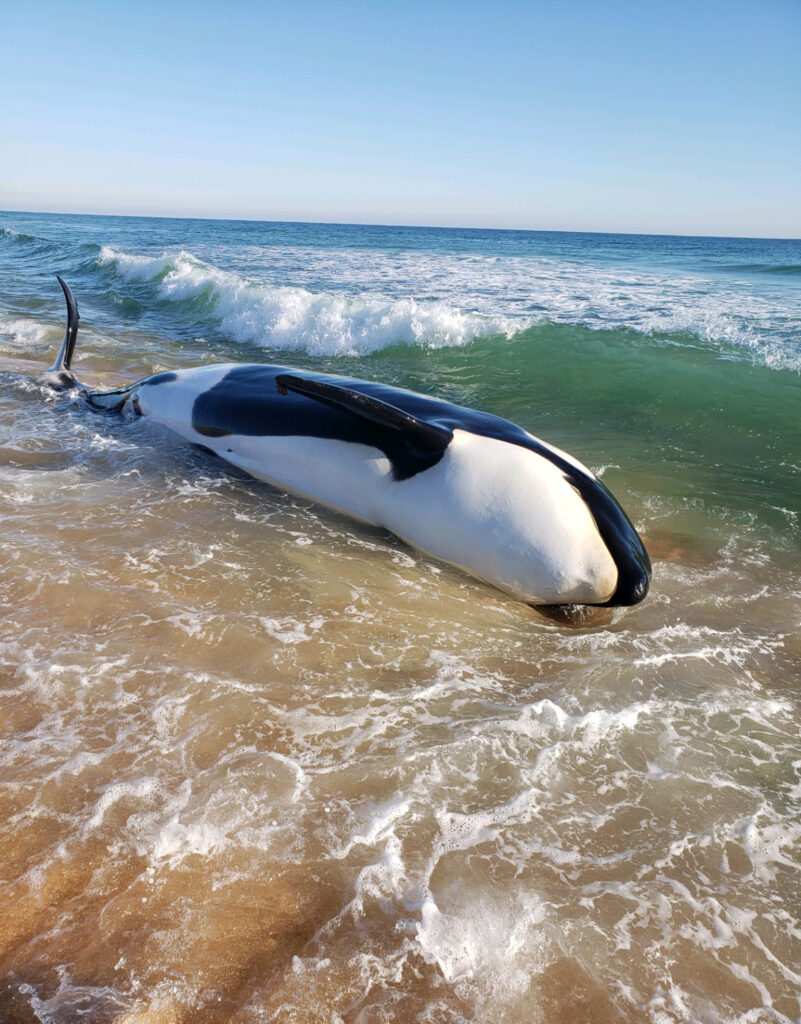When Blair Mase arrived at the Palm Coast beach around 9 a.m. Wednesday, she was in disbelief.
In front of her, a 6,000-pound female killer whale was stranded on the shoreline — a sight never before recorded in Florida. The whale had been beached there for at least three hours by the time Mase had arrived, and curious beachgoers had gathered in droves to take a look.
“It was highly, highly unusual,” said Mase, the Southeast Regional Marine Mammal Stranding Coordinator for the National Oceanic and Atmospheric Administration.

“I’ve been doing this for 30 years, and we have never had a record of a killer whale stranding in Florida — or in the Southeast U.S.,” she said.
The public typically associates orcas with the chillier waters of the Pacific Northwest, where the animals are documented regularly near shore. But there are actually two stocks, or identified populations, found around Florida’s warmer waters, according to Mase. There’s the Western North Atlantic Stock and the Northern Gulf of Mexico Stock, named after the regions where the animals are known to roam.
Orcas have even been observed in the Bahamas and the broader Caribbean, according to Mase.
“We do get sightings of healthy killer whales and killer whale pods from fishermen offshore,” Mase told the Tampa Bay Times over the phone Thursday morning. “But the real rarity is having one actually washed up on the beach.”
What killed the orca?
The 21-foot female orca had worn-out teeth, a signal to scientists that she was old. Her body was brought to SeaWorld, where a team of pathologists and biologists from several organizations, including the University of Florida and Hubbs-SeaWorld Research Institute, worked feverishly overnight to necropsy the animal and take samples.
By Thursday morning, they were able to rule out human interaction as a cause of death, like trauma or plastic ingestion, Mase said. There were also no signs of trauma from military sonar operations, which may be linked to whale beaching deaths.
Instead, early test results showed signs of disease. While the specific illness is still unknown, scientists are shipping samples to a lab, where more information will become available in the coming weeks, Mase said.
Over her three decades of experience collecting animals, Mase said sick and injured marine mammals will often come to the beach to die. When she first got the call about 6:30 a.m. Wednesday, there was speculation the whale was still alive. But biologists are still unable to confirm that detail, she said.
The rare sighting drew so many people to the beach before noon that the Flagler County Sheriff’s Office had to shut down Jungle Hut Road to all traffic, next to the park where the whale was found, the agency posted on social media.
A busy year for whales offshore of Florida
Federal ocean scientists consider the orca to be “the ocean’s top predator.” They’re found in every ocean in the world, and are the most widely distributed whale or dolphin species, according to the National Oceanic and Atmospheric Administration.
The animals were once targeted by hunters and fishers, and threats included commercial hunting and culling to protect angler fish crops, according to the agency. The Southern Resident killer whales, which range from California to southeast Alaska, are the only endangered population of killer whales in the United States.
News of the stranded orca in Flagler County emerged the same morning that hundreds of beachgoers about 200 miles to the south were watching in awe as an endangered North Atlantic right whale mother and calf swam together just offshore of Palm Beach County. The new whale mom, “Pilgrim,” and her calf were swimming south along Florida’s Atlantic coast.
“We’ve had a busy year so far, honestly, with right whale sightings and stranded large whales. So lots of people are seeing them in the water,” Mase said. Right whales are considered one of the world’s most endangered whale species, and the peak calving season runs from December through March.
Mase said she couldn’t help but feel a wave of different emotions when she first saw the dead orca.
“It does tug at your heartstrings to see any stranded marine mammal. But killer whales specifically are just such beautiful creatures,” Mase said.
“But there’s also a lot of curiosity: You want to know why it’s there, and you want to know what killed it. And I was also like, ‘Wow! We have a killer whale on a Florida beach!’ So, there’s just a lot of a lot of different feelings going on.”
___
© 2023 Tampa Bay Times
Distributed by Tribune Content Agency, LLC.



